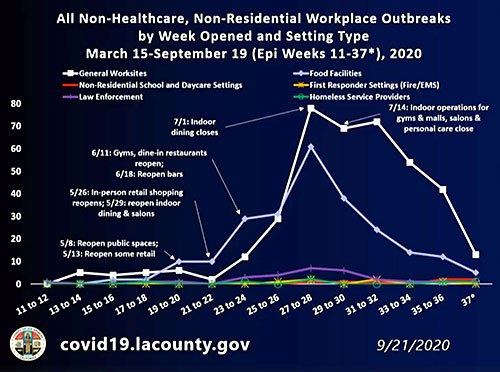Virus restrictions may be relaxed, with words of caution

by Steven Felschundneff | steven@claremont-courier.com
Los Angeles County Department of Public Health announced on Tuesday that the county has met all but one requirement necessary to move to the next tier in the state’s Blueprint for a Safer Economy.
For weeks the county had met most of the metrics set by the state to advance to the next tier, however, the case rate remained stubbornly high. This week it fell to seven cases per 100,000 residents clearing the way for the county to be reclassified from a “widespread” outbreak to a “substantial” one. The final threshold for the county will be maintaining the current case rate for 14 days.
LA County’s positivity rate of 2.8 percent meets the requirement for a “moderate” classification, providing further motivation to see the case rate continue to fall. Advancing to the next tier would allow more businesses to reopen, including gyms and movie theaters.
The potential relaxing of restrictions and reopening more businesses is certainly good news—however, there is a cautionary tale in data reported by public health this week about the impact the previous reopening had on the virus’ spread. In a series of charts, Public Health Director Barbara Ferrer illustrated how outbreaks at workplaces jumped in spring when large swaths of the economy reopened, and then dove once those businesses closed again.
In early May when public spaces and some retail reopened there was a slight increase in confirmed cases of COVID-19 reported at workplaces, but it was still under 75 cases per week. Shortly after May 26 when retail shopping reopened more broadly, followed by indoor dining and salons on May 29, cases increased sharply and continued to rise as the county opened more sectors of the economy. Outbreaks peaked in the middle of July when cases exceeded 250 per week among the general workforce and 200 for food facility workers.
Shutting down indoor dining at restaurants on July 1, followed two weeks later by the closure of gyms, malls, salons and personal care businesses resulted in an immediate drop in the number of workplace outbreaks countywide. In the last two months cases have plummeted among both the general workforce and food workers to fewer than 25 cases per week.
In addition to general workforce and food facility workers, the data is broken down into first responders, law enforcement and homeless service providers. Cases in these three sectors did not follow the same trend as general and food workers, and have been mostly flat the entire time. Law enforcement workers had a small spike in cases beginning in June that subsided fairly quickly. The data excludes healthcare workers which was covered in a separate report.
The county continues to monitor the three-day average of hospitalizations as a stable indicator of how many people are severely ill with COVID-19. That average peaked in mid-July at 2,200 hospitalizations, however, it has been on a steady decline ever since and this week fell to 745. Public health officials are hopeful this trend will continue and an increase in hospitalizations associated with activities that occurred over the Labor Day holiday will fail to materialize.
In its daily news release on Wednesday public health reported 406 cumulative cases of COVID-19 across all areas of Claremont and 13 deaths. Over the past week there have been just six new cases here, an increase of just 1.4 percent.
There is a new instructional outbreak in the city at Oak Park Manor, fortunately they are only reporting one case, a resident at the facility.
Cumulative cases at other Claremont institutions include: Claremont Manor, two staff and two residents; Garces Residential Care, three residents; Mountain View Center, two staff, 16 residents and three deaths; Mount San Antonio Gardens, eight staff, ten residents and three deaths; Sunrise of Claremont five staff and two residents; Western Assemblies Home 13 staff, six residents and one death.
Deaths countywide have continued to decline since the peak two months ago. In late July, the average daily reported deaths was 43, but on September 9, average daily deaths numbered 20. While this decrease is particularly good news, public health officials warn that, if there cases increase in as a result of Labor Day activities, this will likely translate into more hospitalizations and deaths in the coming weeks.
On Wednesday public health reported 31 deaths and 1,265 new cases of COVID-19. Of the 31 deaths, 10 people were among those over the age of 80, while 14 people were between 65 and 79, six were between 50 and 64, and one person was between 30 and 49 years old. Twenty-four people who died had underlying health conditions including nine over the age of 80.
Since its first report in March public health has identified 263,333 cumulative cases of COVID-19 across all areas of L.A. County, and 6,423 deaths.











0 Comments